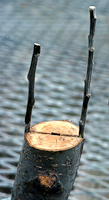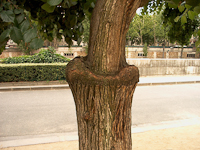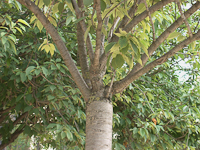|
 |
 Grafting one part of a plant to another plant is an
ancient art. It has been practiced by people for
centuries and centuries. In general terms, grafting is
the result of taking a twig or bud called the scion and
aligning its growing tissue (cambium) with the growing
tissue of a plant which is growing on its own roots
called the stock or rootstock or understock. Grafting one part of a plant to another plant is an
ancient art. It has been practiced by people for
centuries and centuries. In general terms, grafting is
the result of taking a twig or bud called the scion and
aligning its growing tissue (cambium) with the growing
tissue of a plant which is growing on its own roots
called the stock or rootstock or understock.
For this
process to work, several factors must be considered
including:
-
Compatibility -
Although some strange things can be done
sometimes with grafting, the fact is that the
two plants must be compatible or it won't work.
Usually (but not always), this means that the
plants must come from the same genus such as
when two types of apple (Malus) trees are
grafted. A scion from a
Magnolia will not graft
to an apple rootstock.
 However, there are also instances when members
of the same plant Family may be grafted. One
unusual example is the fact that (for fun), a
tomato plant scion may be successfully grafted
onto a potato rootstock. They are both members
of the nightshade (Solonacea) family of
plants. However, there are also instances when members
of the same plant Family may be grafted. One
unusual example is the fact that (for fun), a
tomato plant scion may be successfully grafted
onto a potato rootstock. They are both members
of the nightshade (Solonacea) family of
plants.
To complicate matters, people have discovered a
way to sometimes attach to otherwise
non-compatible plants. They figured out that if
plant A and plant C will not form a good graft
union, this might be overcome by attaching A to
a stem from plant B which is then attached to
plant C. This is called using an inter-stem.
Obviously, plant B is compatible to both A and
C.
-
Timing -
Depending on the type of grafting attempted,
proper timing will be important to success.
Generally, both the scion and stock need to be
in the same stage of growth at the time of
grafting.
-
 Alignment - For a
graft to form a solid union between the scion
and stock, the growing layer or cambium of the
two needs to be aligned so that they are in
contact with each other. The idea is that they
will soon grow together and become one.
Sometimes, a poor alignment will partially
attach and the plant will fall apart several
years later. Alignment - For a
graft to form a solid union between the scion
and stock, the growing layer or cambium of the
two needs to be aligned so that they are in
contact with each other. The idea is that they
will soon grow together and become one.
Sometimes, a poor alignment will partially
attach and the plant will fall apart several
years later.
-
Moisture -
Finally, the place where the two parts are
joined must not be allowed to dry out before the
actually graft takes effect. That is why such
things as grafting rubbers and grafting wax are
used to cover the graft.
|
There are many different
grafting procedures that are used to join plants
together. Some of them are for very specific plants or
situations such as inarching which is used to save trees
whose bark has been damaged by rodents. Also, grafting
may be done "in the field" on plants growing in the
ground or they may be "bench grafted" in the greenhouse
on plants growing in pots.
Different types of graft
process would include whip grafting, side grafting,
cleft grafting, bark graft, approach grafting,
inarching, wedge grafting and bridge grafting. As far as
ornamental landscape plants are concerned, perhaps the
most common type of grafting is called bud grafting or
budding.
|
|
|
|



